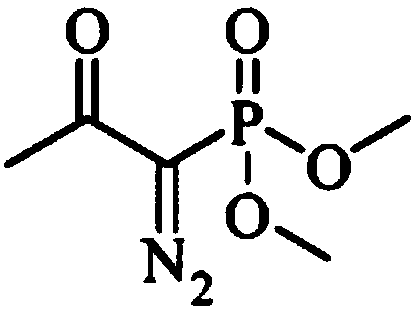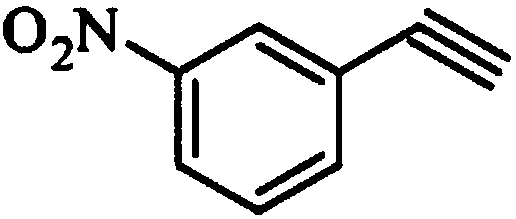M-aminophenylacetylene preparation method
The technology of an aminophenylacetylene and a synthesis method, which is applied in the synthesis field of m-aminophenylacetylene, can solve the problems of unsuitable industrial production, difficult control of reaction conditions and high product cost, and achieves the advantages of less environmental pollution, lower production cost and cost saving. Effect
- Summary
- Abstract
- Description
- Claims
- Application Information
AI Technical Summary
Problems solved by technology
Method used
Image
Examples
Embodiment 1
[0036]Preparation of dimethyl (1-diazo-2-oxopropyl)phosphonate (Bestmann-Ohira reagent). Add 33.2g (0.2mol) of dimethyl acetonyl phosphate and 300ml toluene in sequence in a 1000ml reaction flask, add 5.1g (0.21mol) of NaH in batches, and after all the gas is released, p-toluenesulfonyl azide A mixture of 41.4g (0.21mol) and 500ml of tetrahydrofuran was added to the reaction solution, and the reaction was carried out at room temperature for 16h. After the reaction, add petroleum ether to dilute, filter, wash the filter cake with ether, evaporate the solvent under reduced pressure to obtain 33.1 g of yellow liquid with a yield of 86.5%.
Embodiment 2
[0038] Preparation of dimethyl (1-diazo-2-oxopropyl)phosphonate (Bestmann-Ohira reagent). Add 33.2 g (0.2 mol) of dimethyl acetonyl phosphate and 300 ml tetrahydrofuran in sequence in a 1000 ml reaction flask, add 8 g (0.2 mol) of sodium hydride in batches, and after all the gas is released, p-toluenesulfonyl azide A mixture of 47.3g (0.24mol) and 500ml of tetrahydrofuran was added to the reaction solution, and reacted at room temperature for 12h. After the reaction, dilute with petroleum ether, filter, wash the filter cake with ether, evaporate the solvent under reduced pressure to obtain 33.7 g of yellow liquid with a yield of 88%.
Embodiment 3
[0040] Preparation of m-nitrophenylacetylene. Add m-nitrobenzaldehyde 15.1g (0.1mol) and homemade (1-diazo-2-oxopropyl)phosphonic acid dimethyl ester (Bestmann-Ohira reagent) 18.3g in a dry and clean 1000ml reaction flask (0.11mol) (purified) and 750ml of methanol, cooled to 0-5°C, slowly added 20.7g (0.15mol) of anhydrous potassium carbonate, the temperature was controlled at 0-5°C when adding, after the addition, keep stirring for 2h. Then the reaction temperature was raised to room temperature, and the stirring reaction was continued for 8h. Stop the reaction, add saturated ammonium chloride aqueous solution, dichloromethane 150ml×3 extract, combine the organic phases, and dry over anhydrous sodium sulfate for 2h. Filter, wash the filter cake with an appropriate amount of dichloromethane, combine the organic phases, concentrate under reduced pressure to recover the solvent, freeze and solidify to obtain 13.1 g of a light yellow solid, with a yield of 89.2%.
PUM
 Login to View More
Login to View More Abstract
Description
Claims
Application Information
 Login to View More
Login to View More - R&D
- Intellectual Property
- Life Sciences
- Materials
- Tech Scout
- Unparalleled Data Quality
- Higher Quality Content
- 60% Fewer Hallucinations
Browse by: Latest US Patents, China's latest patents, Technical Efficacy Thesaurus, Application Domain, Technology Topic, Popular Technical Reports.
© 2025 PatSnap. All rights reserved.Legal|Privacy policy|Modern Slavery Act Transparency Statement|Sitemap|About US| Contact US: help@patsnap.com



